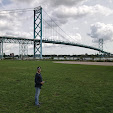From end to end, this bridge is 890 ft long and is comprised of three prominent structural elements: an underdeck Warren truss span at the west shore, a central Pennsylvania-style through truss span, and the highlight swing truss span at its east end. The swing span itself is about 460 ft in length and was among the largest such spans in the world when built; it remains among the largest surviving examples of this kind of construction and is therefore a historically significant structure more than a century after its creation.
Many moveable bridges have draw or bascule spans that enable the bridge’s main span halves to pivot up & down to create an opening for taller boats to navigate through; in the case of a swing bridge, the moveable span rotates or turns laterally about a center turntable pier, thus creating multiple channels for boats to pass through, one on each side of the turntable. The ornate & elegant design of the swing span at this location makes for an extremely unique and memorable structure, one worthy of being the centerpiece of a historic river town like East Haddam.
How to Get There:



















Comments